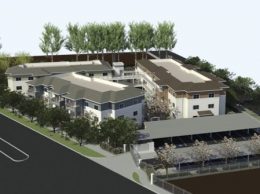Amid falling energy prices, Venoco slims down
IN THIS ARTICLE
- East Ventura County Topic
- Elijah Brumback Author
By Elijah Brumback Friday, October 31st, 2014
Venoco, the Denver-based oil company with significant operations in the Tri-Counties, has signaled to bond holders that it is struggling to manage its debts, and that the company is selling assets and cutting its workforce to help balance the books.
The firm has been on a financial roller coaster since 2012, when founder and CEO Timothy Marquez made a play to take the company private in a $471 million deal.
Recently, Venoco’s chief accounting officer Doug Griggs and chief financial officer Tim Ficker tendered their resignations on the heels of another amendment to the company’s credit facility and the pending divestiture of its West Montalvo oil field — a major gas producing site.
With revenue sagging and pressure mounting to reduce its debt load, Venoco agreed to sell the Oxnard field for $200 million to an unnamed buyer. News of the sale also followed an earlier announcement that the company was cutting just under 10 percent of its workforce. The company said that by hedging against oil price declines and taking other steps it can ride through recent sharp declines in prices for oil and gas.
“We recently closed on the amendment of our revolving credit facility with our bank group, which contemplates a revised borrowing base following the divestiture of our West Montalvo field,” said Venoco Investor Relations Manger Zach Shulman in an email to the Business Times. “This divestiture is moving ahead as currently planned with closing anticipated by the end of October. All of the net proceeds of the sale will be applied towards the credit facility which will go a long way in reducing our total debt balance.”
Venoco acquired the mostly idled field in May 2007 for $61.3 million and would gain about $138.7 million on the sale, excluding the money the firm spent re-working the field to bring wells back into production.
The West Montalvo field is in the midst of being revitalized. The field has both onshore and offshore oil, all of which can be reached by offshore wells. The company had 37 producing wells on the site at the end of last year, most of which were existing wells that had been idle. Venoco was processing data from a 3D seismic survey when the sale of the field was announced, the Business Times previously reported.
In addition to the Montalvo sale, the company also sold 109,000 acres of Monterey shale holdings it had in the Central Valley. It kept 34,000 acres of onshore Monterey shale, much of it in the Santa Maria basin, along with its offshore holdings, which include three drilling rigs in the Santa Barbara Channel. At the time the company said it planned to focus on its three largest fields, most of which are in the Tri-Counties.
The going-private deal, which created much of the big debt burden the company faces, was financed with a mix of bonds and revolving credit lines and imposed financial terms that tighten over time. Venoco must keep its assets and liabilities evenly balanced, and its debts can’t exceed five and a half times its pre-tax earnings, according to company filings.
Venoco had projected that it would be in violation of those terms by the end of September, which could cause its lenders to immediately demand large payments. The company said it planned to ask for a waiver while the West Montalvo field transaction is pending, according to previous Business Times reports.
With crude prices slumping toward $80 per barrel, Shulman said he’s been in constant contact with company bond holders. The falling prices of oil have created liquidity constraints for companies like Venoco with significant borrowings. Still, Shulman said the dip in prices or any further drops are something the company is prepared to handle — even at $70 per barrel.
“The oil and gas business has always been characterized by fluctuating commodities prices, so the recent decline is not something our seasoned team hasn’t dealt with before, and we have measures to address this environment,” Shulman said. “We employ a hedging strategy to reduce the variability of the prices we receive not only to mitigate the impacts to cash flows but also to provide support in executing our capital programs. We have always taken a prudent approach to hedging; a significant portion of our 2014, 2015 and 2016 production is hedged, and we have floors above current market prices. Additionally, as we move forward in formulating our 2015 capital program, we will create a variety of executable scenarios that account for a range of price scenarios – most of our development projects are still economic at $70 per barrel.”
While it’s too early to say for certain what the company’s 2015 capital program will include, recent discussions with its lending group were productive, and the most recent amendment to credit facility allows for the investment of capital into “attractive” projects in Southern California, Shulman said.
“We have an excellent business development team in place that is constantly evaluating fields around California and the nation,” he said. “A lower price environment doesn’t change our outlook or approach which is to find and develop oil and gas assets that are characterized by relatively low decline and long lived reserves.”
In addition to the search for new production sites, Venoco is also considering additional divestitures of non-core assets to improve liquidity. The company is also actively pursuing acquisition opportunities considering the lower price environment and are looking to engage financial partners, Shulman said.
For the first six months of 2014, Venoco’s revenue was down 22 percent to $129.1 million, compared with a year earlier. Net income was $807,000 compared with $36.9 million the same period the previous year.












